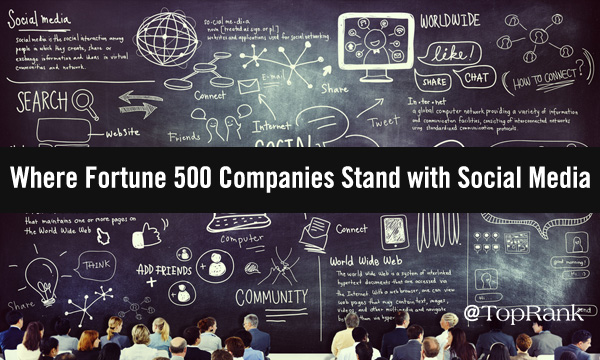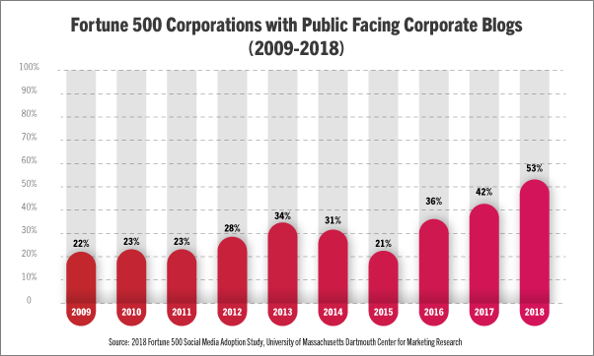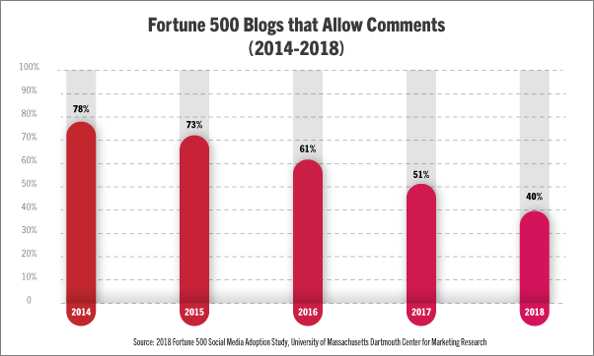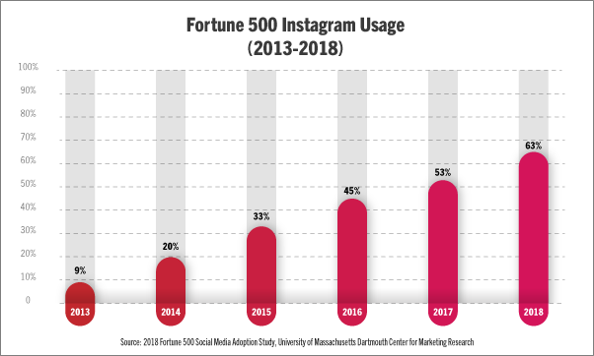
Blogs are booming. Instagram interest is on the rise. Facebook is forever fashionable. And LinkedIn continues to lead the pack.
These all reflect trends found among Fortune 500 companies on social media, according to recent research from the University of Massachusetts Dartmouth’s Center for Marketing Research.
We scoured UMass Dartmouth’s research in search of key takeaways and surprising tidbits that would intrigue and inspire B2B and B2C brands large and small. Here’s what you need to know about how the world’s largest corporations are tackling social media, plus some helpful resources to help give your social media marketing efforts a boost.
More Than Half of F500 Companies Now Have a Blog
It’s kind of amusing to see blogging grouped into this study as a social media tactic. But hey, the research comes from an academic institution, not a marketing entity, and they started conducting it 10 years ago when the lines were more blurred. In any case, there’s still plenty of integration and overlap between blogging and social media (i.e., long-form posts on LinkedIn) so the medium is definitely fair game here.
From 2017 to 2018, Dartmouth’s data finds one of the biggest year-to-year spikes in blog usage since they started tracking in 2008. The percentage of corporate blogs on company websites among Fortune 500 companies is up to 53%, rising 11 points from a year ago.

If that number still seems low to you (it does to me), keep in mind the folks compiling this report aimed to include only blogs that: a) are public-facing, and b) include content that goes beyond “newsroom” type posts such as product announcements, press releases, and philanthropic involvement.
The chart above offers a compelling visualization of the firm traction that content marketing is now seeing in the high-level business world, after failing to truly take off for several years. There’s little reason to think we won’t see this proliferation power ahead at a frantic pace.
Of particular interest, to me, is the rapid decline in number of blogs that allow comments:

This is emblematic of a real conundrum: the internet can be a nasty place. On large and well-trafficked blogs, moderating comments can prove to a be prohibitively time-consuming task. But dialogue is crucial, and preventing readers from being able to respond on corporate blogs really deters the openness and transparency brands should be striving to project.
There’s no easy solution to this dilemma, but one way to inject the voice of your audience in a controlled yet still authentic way is via strategic user-generated content. UGC not only helps you spotlight your customers and their stories, but can also help build rapport and a sense of community, all at a relatively low cost.
In general, we believe blogging is an essential digital marketing tactic for almost any business, large or small. For more insights on driving more targeted traffic to your own corporate blog, check out these recent posts:
Twitter and Facebook are Table Stakes for Top Dogs
Dartmouth reports that 455 of the 2018 F500 companies have active Twitter accounts (91%) and 445 (89%) have Facebook pages. On each, the top 10 companies are all accounted for. Commercial banks and specialty retailers are the only industry verticals with 100% representation across both channels.
It’s inexpensive to create a brand page on Facebook or Twitter, and keeping them updated requires only modest time investment, so it’s hardly surprising to see these high levels of penetration among heavy-hitters.
The great challenge, now and going forward, will be finding ways to stand out and break through on these platforms. On our blog, we make a point of keeping readers up-to-date on changing social algorithms and how marketers can gain visibility on feeds. The posts below can offer some guidance on this front:
Enterprise Instagram Adoption is Exploding
In 2013, 9% of Fortune 500 companies had an Instagram account. In 2018, that figure is up to 63%. As you can see below, the visually oriented platform has seen enormous year-to-year growth in the past half-decade:

It isn’t hard to see why the corporate world is being drawn to Instagram like millennials to a group selfie – everyone’s there. Back in early 2013 the app had 100 million users; here in 2018 it just surpassed 1 billion.
With that astonishing number in mind, it feels like malpractice for any brand not to have some Instagram presence. But how can you really connect with audiences there? What are B2B brands and big companies doing successfully on this leisure-driven platform? Here are some posts that can help you see the big picture, with examples and actionable tips:
Fortune 500 Companies Are All-In on LinkedIn
While Facebook and Twitter are creeping upward, and Instagram is experiencing rapid growth, LinkedIn remains the leader in terms of F500 penetration. The Dartmouth report shows 489 of the companies (98%) with a presence on the platform, same as last year and up slightly from 97% in 2016.
Given its business-oriented context, and its audience of more than 500 million professionals, LinkedIn is clearly a no-brainer for any major company. I’m actually shocked that 100% of Fortune 500 brands aren’t linked up.
Check out these articles for tips on tightening up your LinkedIn game:
Social Media is Big Business
Across all channels and platforms, the world’s most powerful corporations are increasingly recognizing social media marketing as a necessity rather than a nice-to-have — a trend we expect will continue into 2019.
UMass Dartmouth’s research finds that an overwhelming majority of 2018 F500 companies are present on LinkedIn, Twitter, and Facebook; meanwhile, visually-driven networks like Instagram and YouTube are picking up steam fast in alignment with evolving user preferences.
If you want to get the full scoop on Fortune 500 social media usage, check out the full report. And if you’re hankering for more analysis of social media marketing trends in 2018, we’ve got you covered:

Comments are Closed